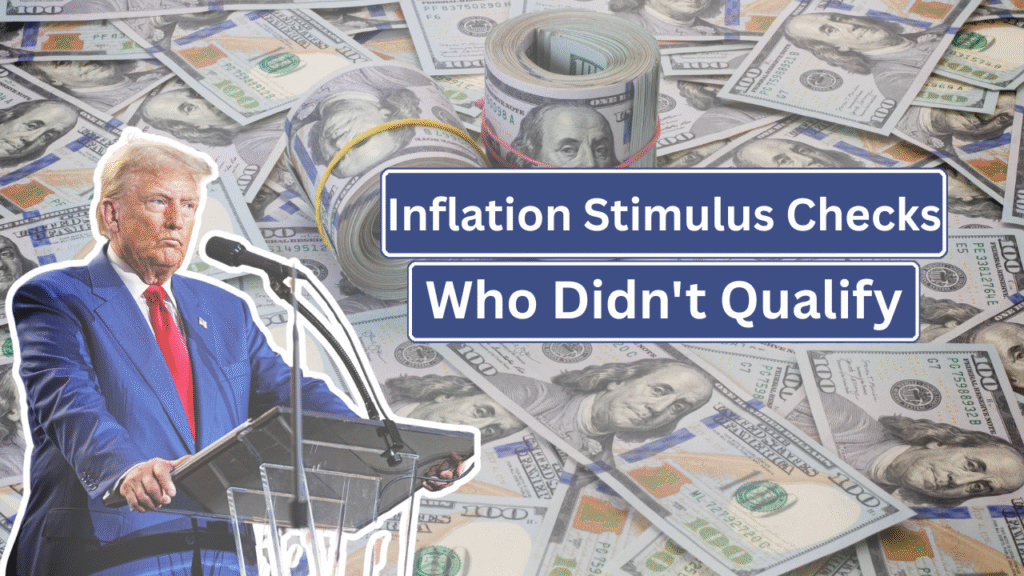As the cost of living continues to rise due to persistent inflation, Americans are feeling the pinch in their everyday expenses – from groceries to gas and housing. While the federal government has not issued a new round of inflation-specific stimulus checks in 2025, several states have launched their own relief programs. However, these efforts haven’t reached everyone. This article explores who has received inflation-related payments, who has been left out, and why.
The End of Federal Stimulus and Rise of State-Level Aid

The last major federal stimulus came during the COVID-19 pandemic, with the final round of Economic Impact Payments distributed in 2021. Since then, the federal government has not passed additional legislation for nationwide relief tied specifically to inflation. The deadline to claim the Recovery Rebate Credit for missed stimulus payments expired on April 15, 2025, closing the door on retroactive claims.
In the absence of new federal aid, several states have stepped in:
- California offered its Middle Class Tax Refund in 2022–2023, sending payments of up to $1,050.
- New York initiated an inflation relief program in 2024 offering payments between $150 and $400 to qualifying households.
- Colorado, New Mexico, Idaho, and others have also offered rebates or refunds, often tied to income tax filings or residency criteria.
Groups Left Behind
Despite these state-led efforts, millions of Americans have not received any inflation relief. Several groups stand out as being disproportionately excluded:
Non-Tax Filers: Many relief programs are tied to income tax filings. Seniors, low-income workers, and individuals who are not required to file taxes may be unaware of eligibility or unable to claim benefits.
Undocumented Immigrants: Individuals without a valid Social Security number are ineligible for most federal and state stimulus programs, even though many pay taxes using an ITIN (Individual Taxpayer Identification Number).
Recent Movers: People who moved between states may not meet the residency duration requirements set by individual state programs.
College Students and Young Adults: Young adults who were previously claimed as dependents on their parents’ taxes may not qualify for state checks issued to the household, despite facing high living costs on their own.
Stimulus by Other Names: Tribal and Local Support
Certain Native American tribes, such as the Pokagon Band of Potawatomi, have independently provided inflation relief to members. In 2025, the tribe offered monthly payments of $140 to $250 per household, depending on household size and enrollment.
Similarly, some counties and cities have offered limited cash assistance to low-income residents, although such programs are typically small-scale and subject to available funding.
Economic Impact and Public Pressure

As inflation persists, public pressure has mounted for broader support. A 2024 poll found that 62% of Americans support another round of federal stimulus, particularly aimed at low-income households and seniors on fixed incomes.
Economists are divided. Some argue that more direct payments could fuel inflation further by increasing consumer spending. Others believe targeted assistance – particularly for housing, food, and utilities – could ease the burden without significantly impacting inflationary pressures.
Alternative Relief Options
In lieu of new stimulus checks, several forms of assistance remain available:
- Supplemental Nutrition Assistance Program (SNAP): Offers food benefits to eligible low-income individuals.
- Low Income Home Energy Assistance Program (LIHEAP): Provides help with utility and energy bills.
- Earned Income Tax Credit (EITC): A tax credit available to working individuals with low to moderate income.
Still, these are not substitutes for direct inflation-linked payments and often require a time-consuming application process.
Conclusion
While some Americans have received relief from rising inflation through state or local programs, millions have not. Those who don’t file taxes, lack permanent addresses, or reside in states without aid programs are falling through the cracks.
With the inflation rate still hovering above pre-pandemic levels and wages not always keeping pace, the debate over federal stimulus has not disappeared. As policymakers weigh long-term fiscal stability against immediate needs, the question remains: how can relief be distributed fairly – and fast enough – to those who need it most?
For information on current support programs, residents are encouraged to consult their local or state government websites and financial assistance offices.




